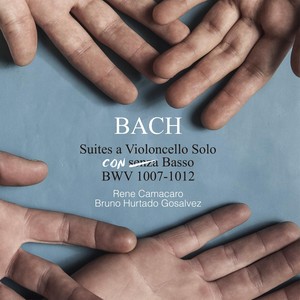
Bach: Suites a Violoncello Solo Con Basso
- 歌唱: Rene Camacaro/ Bruno Hurtado Gosalvez
- 发行时间:2016-07-01
- 唱片公司:Cezanne Producciones
- 类型:录音室专辑
- 歌曲
- 时长
-
作曲家:Johann Sebastian Bach
-
作品集:Suite No. 1 in G Major, BWV 1007
-
作品集:Suite No. 5 in C Minor, BWV 1011
-
作品集:Suite No. 3 in C Major, BWV 1009
-
作品集:Suite No. 4 in E-Flat Major, BWV 1010
-
作品集:Suite No. 5 in C Minor, BWV 1011
-
作品集:Suite No. 3 in C Major, BWV 1009
-
作品集:Suite No. 1 in G Major, BWV 1007
-
作品集:Suite No. 2 in D Minor, BWV 1008
-
作品集:Suite No. 6 in D Major, BWV 1012
-
作品集:Suite No. 2 in D Minor, BWV 1008
-
作曲家:Johann Sebastian Bach
-
作品集:Suite No. 4 in E-Flat Major, BWV 1010
-
作曲家:Rene Camacaro
简介
"The Bach cello suites were considered “practice pieces” before Pau Casals recorded them. But since Casal’s discovery, the suites have come to be recognised as a treasure chest full of surprises, especially for those fortunate musicians like us who can enjoy the privilege of playing notes from the scores every day. One day, I was playing a dance from one of the suites when Bruno came into the practice room, unexpectedly, and started playing with me .He is the kind of person who takes his cello and starts playing with you without having anything in mind. It is this spirit of improvisation that has led to the recording of this CD. Bach composed the suites for SOLO cello, but the mutual sensation we experienced on playing together, with a bass, was so exciting that we did not stop. We carried on unconsciously, and just let the music flow. Why it should be so exhilarating and fulfilling to play the suites like this still remains a mystery for us, and for this reason we want to share the experience with you." -Rene Camacaro "After so many hours spent studying in small practice rooms, eventually a cellist turns up and starts playing with you, freeing you from routine. Cellists like playing together .Two instruments alike that work well with each other. Bach’s cello suites came to be one of the standard repertoire pieces for us, and they have been played in thousands of different ways. However, for me there was always something lacking. I thought about le Sieur de Sainte Colombe and his “concerts” for two viola da gamba, and how they present a main voice and a second one that seems to fill in the gaps. One is reminded of lutes and theorbes. With this in mind, Rene and I decided to start improvising. At first, it was just a bass line, which led to a better understanding of the harmony, but then it went on to become counterpoint. What we do here is not intended to be a “historical interpretation”. Furthermore, it is not expected to be everybody’s “cup of tea.” It is simply the way we understand the music; the way we see it today, after having experienced the way we played the cello suites together in those small practice rooms a long time back. We hope you enjoy it." Bruno Hurtado Gosalvez Rene Camacaro was born into a musician’s family and began playing the cello when he was eight years old. He studied in Madrid with Jose Miguel Gomez, in London with Louise Hopkins, and in Bern with Antonio Meneses. He is also a composer. Bruno Hurtado was born into a musician’s family and started his musical education at the age of seven. He studied the violoncello, first with Mark Friedhof, and later with Peter Thiemann, Roel Dieltiens, and Louise Hopkins. His interest in early music and historical performance practice led him to the study of the baroque cello and the viola da gamba, with Lorenz Duftschmid. Today, he plays with different ensembles and formations throughout Europe.

